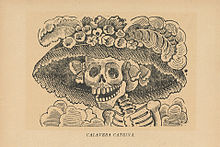José Guadalupe Posada

José Guadalupe Posada (February 2, 1852 – January 20, 1913[1]) was a Mexican political printmaker and engraver whose work has influenced many Latin American artists and cartoonists because of its satirical acuteness and social engagement. He used skulls, calaveras, and skeletons to make political and cultural critiques.
Early life and education

Posada was born in Aguascalientes on February 2, 1852. His education in his early years was drawn from his older brother Cirilo, a country school teacher, who taught him reading, writing and drawing. As a young teenager he went to work in the workshop of Trinidad Pedroso, who taught him lithography and engraving.
Career as artist

In 1871, before he was out of his teens, his career began with a job as the political cartoonist for a local newspaper in Aguascalientes, El Jicote ("The Bumblebee"). The newspaper closed after 11 issues, reputedly because one of Posada's cartoons had offended a powerful local politician.[2] He then moved to the nearby city of León, Guanajuato. There Posada was married to Maria de Jesús Vela on September 20, 1875. In Leon, a former associate of his from Aguascalientes assisted him in starting a printing and commercial illustration shop. They focused on commercial and advertising work, book illustrations, and the printing of posters and other representations of historical and religious figures. Included among these figures were the Virgin of Guadalupe, the Virgin, the Holy Child of Atocha and Saint Sebastian.
In 1883, following his success, he was hired as a teacher of lithography at the local Preparatory School. The shop flourished until 1888 when a disastrous flood hit the city. He subsequently moved to Mexico City. His first regular employment in the capital was with La Patria Ilustrada, whose editor was Ireneo Paz, the grandfather of the later famed writer Octavio Paz. He later joined the staff of a publishing firm owned by Antonio Vanegas Arroyo and while at this firm he created a prolific number of book covers and illustrations. Much of his work was also published in sensationalistic broadsides depicting various current events.
Notable works
Posada's best known works are his calaveras, which often assume various costumes, such as the Calavera de la Catrina, the "Skull of the Female Dandy", which was meant to satirize the life of the upper classes during the reign of Porfirio Díaz. Most of his imagery was meant to make a religious or satirical point. Since his death, however, his images have become associated with the Mexican holiday Día de los Muertos, the "Day of the Dead".
Later life
Largely forgotten by the end of his life, Posada's engravings were brought to a wider audience in the 1920s by the French artist Jean Charlot, who encountered them while visiting Diego Rivera. While Posada died in poverty, his images are well known today as examples of folk art. The muralist José Clemente Orozco knew Posada when he was young, and would look at him work though a window on the way to school, and credited Posada's work as an influence on his own.
Further Reading

- Ades, Dawn, Art in Latin America: The Modern Era, New Haven, (Yale University Press), 1989, pp. 354, 110-123.
- Art Encyclopedia, Vol 25, p. 321.
- Catlin, Stanton, Art of Latin America Since Independence, New Haven, (Yale University Press, 1966), p. 190.
- Frank, Patrick, Posada's Broadsheets: Mexican Popular Imagery 1890-1910 (Albuquerque: University of New Mexico Press, 1998).
- Montes i Bradley, Ricardo Ernesto, "Nuevo y valioso aporte al conocimiento de Posada”, Novedades. Mexico. D.F. May 4. 1952. The essay is an introduction to a publication containing 134 engravings by José Guadalupe Posada. [3]
- Posada, José Guadalupe, Posada’s Popular Mexican Prints, NY, (Dover Publications, 1972)
- Rothenstein, Julian, Posada: Messenger of Mortality, NY, (Moyer Ltd, 1989)
- Tenenbaum, Barbara, Encyclopedia of Latin American History and Culture, New York, (Scribner’s, 1996), p. 457, Vol 14.
- Tyler, Ron, ed., Posada’s Mexico, Washington, (Library of Congress, 1979)
References
- ^ Nick Caistor, Mexico City: A Cultural and Literary Companion (Interlink Books, 2000)p115
- ^ History of Mexico - Mexico's Daumier: Josejhg Guadalupe Posada, by Jim Tuck in Mexico Connect
- ^ Flores Villela, Carlos Arturo. "México, la cultura. el arte y la vida cotidiana. Vol 1". Serie Fuentes 7. p. 213. Centro de Investigaciones Interdisciplinarias en Humanidades. Universidad Autónoma de México.
External links
- Print collection and information
- José Guadalupe Posada at the University of New Mexico
- Mexico's Daumier: José Guadalupe Posada
- José Guadalupe Posada: My Mexico, a traveling exhibit
- Posada - Mexico Connect
- Vanegas Arroyo-Posada Film Documentary Information
- Collection of José Guadalupe Posada Etchings and Broadsides at Artspawn
- TEDx Posada Lecture on YouTube
- Brady Nikas collection and information
- American Museum of Ceramic Art: Tribute to Jose Guadalupe Posada's La Catrina
